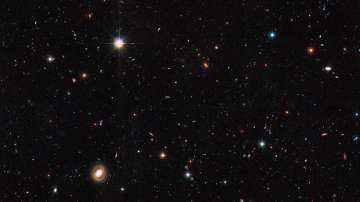The universe contains a dizzying two trillion galaxies, up to 20 times more than previously estimated, new research has found.
Over the last 20 years scientists have used images from the Hubble Space Telescope to estimate that the universe we can see contains around 100 - 200 billion galaxies.
Now, an international team led by Christopher Conselice, Professor at The University of Nottingham in the UK, has shown that the number of galaxies in our universe is at least two trillion, 20 times more than previously thought - the often quoted value of around 100 billion.
Current astronomical technology allows us to study a fraction of these galaxies - just 10 per cent. It means that over 90 per cent of the galaxies in our universe are yet to be discovered, and will only be seen once bigger and better telescopes are developed.
"We are missing the vast majority of galaxies because they are very faint and far away. The number of galaxies in the universe is a fundamental number we would like to know, and it boggles the mind that over 90 per cent of the galaxies in the universe have yet to be studied," said Conselice.
"Who knows what interesting properties we will find when we study these galaxies with the next generation of telescopes. These galaxies will likely hold the clues to many outstanding astrophysical issues," he said.
The team converted pencil beam images of deep space from telescopes around the world, especially from the Hubble telescope, into 3D maps to calculate the volume as well as the density of galaxies of one tiny bit of space after another.
This painstaking research enabled them to establish how many galaxies we have missed - much like an intergalactic archaeological dig, researchers said.
The results of this study are based on the measurements of the number of galaxies at different epochs - different instances in time - through the universe's history.
Conselice and his team at Nottingham, in collaboration with scientists from Leiden University in the Netherlands and the University of Edinburgh in the UK, examined how many galaxies there were in a given value they found that this increased significantly at earlier times.
In fact, it appears that there are a factor of 10 more galaxies in a given volume of space when the universe was a few billion years old compared with today, researchers said.
Most of these galaxies are low mass systems with masses similar to those of the satellite galaxies surrounding the Milky Way.
"This is very surprising as we know that over the 13.7 billion years of cosmic evolution galaxies are growing through star formation and merging with other galaxies," Conselice added.
The research was published in the Astrophysical Journal.
(With agency inputs)
Latest World News
